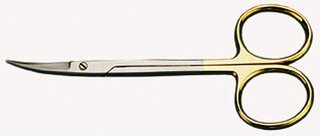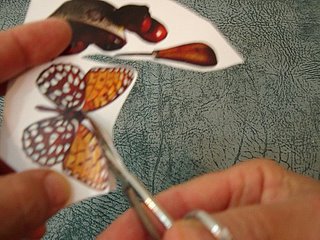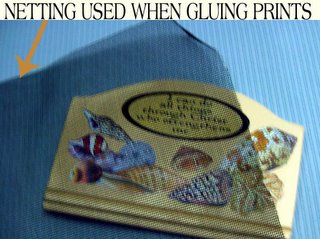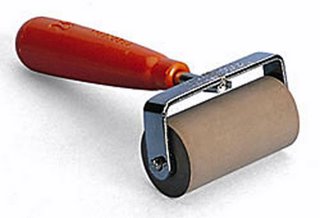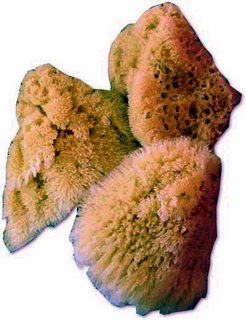 Plastic serving dish
Plastic serving dish
To do decoupage on plastic, you need to sand back the plastic to give the surface a "tooth" to work on ... in other words, for the paint to adhere to. You will also need to apply at least one coat of Liquitex matt medium, and allow it to cure for a few days before commencing with your decoupage project. This will ensure that your background color paint sticks firm to the plastic object and does not start peeling off creating air bubbles below your design. After all, you are going to spend quite a bit of time making your special creation, you will not want it ruined simply because you were in too much of a hurry to get started.
While you are waiting for your background preparation to cure, you can use that time to cut your pictures and layout your design temporarilly on a piece of scrap paper ready to transfer to the object when it is quite well cured. Decoupage teaches you to be patient ... and you will find the time delay waiting to start applying the design well worth it in the end as your finished gift or personal decorator item will last for many years to come.
You can create many beautiful things from cheap "$2.00 SHOP" items. Apply Faux Paint Finishes and decoupage prints to make great looking antique, modern or vintage look items. These are so much fun to do!
You can also print your own pictures.
You can find lots of CD's with a variety of decoupage and craft prints right here and on my website..
http://artbyjean.org Just choose the one you like then print as many copies as you wish to make marvelous gifts and decoupage projects that reflect your creative instincts.
My craft prints can be used for tea bag folding,decoupage, home decorating, scrapbooking and other paper craft. My designs include borders, tea bag tiles, decoupage prints, stripes, plaids, novelty signs, florals, fruit and vegetable designs, scrapbooking pages that you can print yourself from your PC or Mac, Various shapes in Tea Bag Tiles ... oval tiles, square tiles, round tiles, split tiles, flower tiles with 6 petals and flower tiles with 8 petals. Included on most of my CD's are circle templates that can be used to layout your medallions with 5, 6, 7, 8, 9, 10, or even more segments. These can also be used when doing decoupage to layout your prints evenly spaced in a circular pattern.
FIND PRINTS FOR THE FOLLOWING:
Tea bag tiles, Tea bag tiles on CD, decoupage prints, origami, decoupage prints on CD, scrapbook, scrapbooking, scrapbook albums, layout pages, pages, tiles to make medallions, card fronts, pretty background patterns, prints for decorating stuff, tea bag folding, cards, crafts, paper prints, decorate, decorative crafts, papers, cut outs, decorative butterflies, bows, carckle, backgrounds, stripes, plaids, flowers, oval tiles, square tiles, round tiles, flower tiles with 6 petals, flower tiles with 8 petals, folds, folding instructions, do it yourself projects, clipart, print them yourself, prints for do it yourself projects. circle layout pages for positioning your folded tea bag tiles, or your decoupage prints.WHAT YOU CAN DECORATE: Antique baths, art boxes, ash trays, bed heads, binder covers, book covers,book marks, bookends, bowls, boxes, broaches, BYO wine holders, candleboxes, candlesticks, canisters, CD racks, ceiling, ceramic bisque, chairs,chess boards, chest of drawers, chests, childs bench, childs furniturechocolate boxes, cigar boxes, clocks, coasters, collage, crash helmets,cupboard doors, cutlery boxes, decoys, dishes, document trays, doll furniture, dolls house furniture, dolls houses, door furniture doorstops,egg racks, fire screens, foot stools, frames, fruit bowls, fruit boxes,furniture, game boards, garden bulb storage boxes, greeting cards,hair clips, hand mirrors, hat boxes, home decorating projects, jewel boxes,journal covers, kids benches, kids furniture, lamps, lap desks, lazy susan, leg and arm casts, letter boxes, letter trays, magazine racks, matchboxes,old metronome, mirror frames, mobiles, mood indicators, music boxes,musical instruments, napkin holders, napkin rings, old irons, old kettles,old suitcases, old telephones, old tin buckets, paper mache objects,paper tole, paper weights, pedestals, pencil holders, pianos, picture frames,placemats, plant pots, framed prints, planters, plaques, plaster cast items,plastic dishes, plates, playing card boxes, recipe boxes, scrapbooks, screens, seed boxes, sewing boxes, shoe shine boxes, signs,skate boards, soap boxes, soaps, special invitations, stamp boxes, stones,stools, switch plates, table tops, coffee tables, the refrigerator,tissue box covers, toilet seats, tool boxes, trays, trivets, trunks, vases,walking canes, waste baskets, shoes, welcome signs, wind barrels,wood floor, concrete floor, wood ironing boards, old saws, personal invitations, greeting cards, notepaper, homepreserve jars, plant pots, church bulletins, church notices, announcements,invitations, blackboards, old unusable CD's, picture frames, IN and OUT trays, precious paintbrush handles, and the list goes on ....
